Many
of you probably already know this but according to a famous Catholic prophet of
the 12th century, the next pope will be the very last one. He will be the
anti-Christ pope when Jesus returns. Here's the info on all the popes
including the "last one" [according to the prophesy] who will be
elected in Rome somewhere around March 1, 2013.
Prophecys
about popes by saint Malachy in 12th century....
The prophecy was first
published in 1595 by Arnold de Wyon, a Benedictine
historian, as part of his book Lignum Vitæ. Wyon attributed the
list to Saint Malachy,
the 12th‑century bishop of Armagh in Ireland. According to the traditional
account, in 1139, Malachy was summoned to Rome by Pope Innocent II.
While in Rome, Malachy purportedly experienced a vision of future popes, which
he recorded as a sequence of cryptic phrases. This manuscript was then
deposited in the Roman Archive, and thereafter forgotten about until its
rediscovery in 1590.
On the other hand, Bernard of Clairvaux's
biography of Malachy makes no mention of the prophecy, nor is it mentioned in
any record prior to its 1595 publication.[1] Some
sources, including the most recent editions of the Catholic
Encyclopedia, suggest that the prophecy is a late 16th‑century forgery. Some have suggested that it was
created by Nostradamus and was
credited to Saint Malachy so the purported seer would not be blamed for the
destruction of the papacy. Supporters, such as author John Hogue, who wrote a
popular book titled The Last Pope about the claims, generally argue
that, even if the author of the prophecies is uncertain, the predictions are
still valid.
Interpretation
Interpretation of the
mottos has generally relied on finding correspondences between the mottos and
the popes' birthplaces, their personal arms,
and the events of their pontificates. For example, the first motto, Ex
castro Tiberis (From a castle on the Tiber), fits Pope Celestine II's
birthplace in Città
di Castello, on the Tiber.
Pope Clement XIII,
referred to in the prophecy as Rosa Umbriae, the rose of Umbria, is stated to have used a rose
"as his personal emblem" (his coat of arms does not include one,
however, nor was he from Umbria nor had any but the most marginal connection
with the region, having been briefly pontifical governor of Rieti, at the time part of Umbria). The
technique of word play was
evident in instances where interpreters find a phrase fitting more than one
explanation.
It is notable that where
the interpretation of the prophecy is clear (as is the case for almost all of
the Popes prior to 1590), the reference is almost always to some characteristic
possessed by the Pope prior to assuming the Papacy—e.g., his birthplace, his
arms, his surname, or his cardinal see. However, for more recent Popes, efforts
to connect the prophecy with the pope have often focused on the events of his
pontificate.
In recent times, some
interpreters of prophetic literature have drawn attention to the prophecies,
both because of their success in finding connections between the prophecies and
recent popes, and because of the prophecies' imminent conclusion.
Interpretations made before the elections of recent popes have not generally
predicted their papacies accurately.
Popes and corresponding mottos
This list, adapted from The
Prophecies of St. Malachy by Peter Bander, begins its numbering two numbers
ahead of the Vatican's numbering of popes (Benedict XVI is the 265th, not the
267th). The reason for this is unclear (perhaps because of the two purported
"anti-popes").
The list can be divided
into two groups; one of the 74 Popes and Antipopes who reigned prior to the
appearance of the Prophecy in 1590, for whom the connection between the motto
and the Pope is usually clear but can be seen as postdiction. The
other is of the 38 Popes who have reigned since 1590, for whom the connection
between the motto and the Pope is often strained or totally opaque and could be
viewed as shoehorning
Popes 1590
to present
For this group of Popes, the published
text only provides names for the first three (i.e., those who were Popes
between the appearance of the text in 1590, and its publication in 1595) and
attempts no explanations.|
Post-appearance
Popes (1590–present)
|
|||||
|
Pope No.
|
Motto (Translation)
|
Regnal Name
(Reign)
|
Name
|
Historical
Reference or Explanation
|
Coat of Arms
|
|
Ex antiquitate
Vrbis.
|
Gregorius. XIIII.
|
||||
|
231
|
75 Of the antiquity of the city
|
Gregory XIV (1590–1591)
|
Niccolo Sfondrati
|
His father was a senator of the ancient city of Milan. The
word "senator" is derived from the Latin senex, meaning old
man.
|
|
|
Pia ciuitas in
bello.
|
Innocentius. IX.
|
||||
|
232
|
76 Pious city in war
|
Innocent IX (1591)
|
Giovanni Antonio Facchinetti
|
He was Patriarch of Jerusalem before succeeding
to the Papacy.
|
|
|
Crux Romulea.
|
Clemens. VIII.
|
||||
|
233
|
77 Cross of Romulus
|
Clement VIII (1592–1605)
|
Ippolito Aldobrandini
|
||
|
Vndoſus uir.
|
|||||
|
234
|
78 Wavy man
|
Leo XI (1605)
|
Alessandro Ottaviano De Medici
|
He had been the Bishop of Palestrina.[54] The ancient Romans attributed the origins of Palestrina to the seafaring hero Ulysses.[55] Also, he had only reigned for 27 days.
|
|
|
Gens peruerſa.
|
|||||
|
235
|
79 Corrupted nation
|
Paul V (1605–1621)
|
Camillo Borghese
|
Pope Paul scandalised the Church when he appointed his
nephew to the College of Cardinals. The
word "nepotism" may have originated during this pope's
reign.[56]
|
|
|
In tribulatione
pacis.
|
|||||
|
236
|
80 In the trouble of peace
|
Gregory XV (1621–1623)
|
Alessandro Ludovisi
|
His reign corresponded with the outbreak of the Thirty Years' War.
|
|
|
Lilium et roſa.
|
|||||
|
237
|
81 Lily and rose
|
Urban VIII (1623–1644)
|
Maffeo Barberini
|
||
|
Iucunditas crucis.
|
|||||
|
238
|
82 Delight of the cross
|
Innocent X (1644–1655)
|
Giovanni Battista Pamphili
|
He was raised to the pontificate around the time of the Feast of the
Exaltation of the Cross after a long and difficult conclave.
|
|
|
Montium cuſtos.
|
|||||
|
239
|
83 Guard of the mountains
|
Alexander VII (1655–1667)
|
Fabio Chigi
|
His family arms include six hills with a star above them.[58]
|
|
|
Sydus olorum.
|
|||||
|
240
|
84 Star of the swans
|
Clement IX (1667–1669)
|
Giulio Rospigliosi
|
The "star" in the legend refers Pope Alexander
VII, who had made Clement his personal secretary.[58] The Italian word for swan, cigni,
rhymes with Pope Alexander's surname, "Chigi."
|
|
|
De flumine magno.
|
|||||
|
241
|
85 From a great river
|
Clement X (1670–1676)
|
Emilio Altieri
|
Pope Clement was a native of Rome.
|
|
|
Bellua
inſatiabilis.
|
|||||
|
242
|
86 Insatiable beast
|
Innocent XI (1676–1689)
|
Benedetto Odescalchi
|
Pope Innocent had a lion on his coat of arms.[58]
|
|
|
Pœnitentia
glorioſa.
|
|||||
|
243
|
87 Glorious penitence
|
Alexander VIII (1689–1691)
|
Pietro Ottoboni
|
His first name was "Pietro", after the apostle
Peter who had repented after having denied Christ thrice.
|
|
|
Raſtrum in porta.
|
|||||
|
244
|
88 Rake in the door
|
Innocent XII (1691–1700)
|
Antonio Pignatelli del Rastrello
|
His full name was Antonio Pignatelli del Rastrello.[59] "Rastrello" in Italian means
"rake."
|
|
|
Flores circundati.
|
|||||
|
245
|
89 Surrounded flowers
|
Clement XI (1700–1721)
|
Giovanni Francesco Albani
|
He had been a cardinal with the title of Santa Maria in
Aquiro.[60]
|
|
|
De bona religione.
|
|||||
|
246
|
90 From good religion
|
Innocent XIII (1721–1724)
|
Michelangelo dei Conti
|
A play on words, referring to the pope's regnal name. He
was from the famous Conti family that had produced several Popes.
|
|
|
Miles in bello.
|
|||||
|
247
|
91 Soldier in War
|
Benedict XIII (1724–1730)
|
Pietro Francesco Orsini
|
Before he was pope there was a lot of wars in nearby
countries, and it is possible he could have fought in one as a soldier.
|
|
|
Columna excelſa.
|
|||||
|
248
|
92 Lofty column
|
Clement XII (1730–1740)
|
Lorenzo Corsini
|
When still a cardinal, he had held the titular church of
St Peter in Chains.[61] The name "Peter" is derived from the
Greek word "petros," meaning "rock." Clement was a
frustrated architect who ordered, and sometimes interfered with, the building
of many churches. He managed to salvage two columns of the Parthenon for his chapel at Mantua.
|
|
|
Animal rurale.
|
|||||
|
249
|
93 Country animal
|
Benedict XIV (1740–1758)
|
Marcello Lambertini
|
Might be a play on words because of his famous laws about
missions in the two papal bulls'‘.
|
|
|
Roſa Vmbriæ.
|
|||||
|
250
|
94 Rose of Umbria
|
Clement XIII (1758–1769)
|
Carlo Rezzonico
|
He had been a cardinal with the titular church of Santa Maria in Aracoeli.[62] In mystical circles, the Virgin Mary is
represented by a rose.
|
|
|
Vrſus uelox.
|
|||||
|
251
|
95 Swift bear (later misprinted as Cursus velox Swift
Course or Visus velox Swift Glance)
|
Clement XIV (1769–1774)
|
Lorenzo Giovanni Vincenzo Antonio Ganganelli
|
The Ganganelli family crest bore a running bear.
|
|
|
Peregrin9
apoſtolic9.[63]
|
|||||
|
252
|
96 Apostolic pilgrim
|
Pius VI (1775–1799)
|
Giovanni Angelico Braschi
|
Spent the last two years of his life in exile, a prisoner
of the French Revolution.
|
|
|
Aquila rapax.
|
|||||
|
253
|
97 Rapacious eagle
|
Pius VII (1800–1823)
|
Barnaba Chiaramonti
|
The Pope's pontificate was overshadowed by Napoleon,
whose emblem was the eagle.
|
|
|
Canis &
coluber.
|
|||||
|
254
|
98 Dog and adder
|
Leo XII (1823–1829)
|
Annibale Sermattei della Genga
|
"Dog" and "snake" are common insults,
and Leo was widely hated[citation needed]. The legend
could be an allusion to the pope's last name, Sermattei. "Serpente"
is the Italian word for snake.
|
|
|
Vir religioſus.
|
|||||
|
255
|
99 Religious man
|
Pius VIII (1829–1830)
|
Francesco Saverio Castiglioni
|
Another play on words, referring to the pope's regnal
name.
|
|
|
De balneis
Ethruriæ.
|
|||||
|
256
|
100 From the baths of Tuscany
|
Gregory XVI (1831–1846)
|
Mauro, or Bartolomeo Alberto Cappellari
|
Pope Gregory XVI belonged to the Camaldolese Order, which is said to have begun
with two monastic houses. The first of these houses was Campus Maldoli, and
the second was Fonte Buono, meaning "good fountain" in Italian.[64]
|
|
|
Crux de cruce.
|
|||||
|
257
|
101 Cross from cross
|
Bl. Pius IX (1846–1878)
|
Giovanni Maria Mastai Ferretti
|
During his pontificate, the House of Savoy, whose coat of arms is a white
cross on a red background, reunited
Italy and stripped the pope of his territorial possessions. Pope Pius XII, commenting on the beatification
process of Pius IX, used the words per crucem ad lucem (through the
cross to light). Pius IX was finally beatified by Pope John Paul II in 2000.
|
|
|
Lumen in cœlo.
|
|||||
|
258
|
102 Light in the sky
|
Leo XIII (1878–1903)
|
Gioacchino Pecci
|
His coat of arms had a shooting star.
|
|
|
Ignis ardens.
|
|||||
|
259
|
103 Burning fire
|
St. Pius X (1903–1914)
|
Giuseppe Sarto
|
Pius advocated the codification of Canon law, daily communion and the use of Gregorian chant in the Catholic liturgy, and was an opponent of Modernism. He was
the first pope to be declared a saint in over 400 years, the previous one
being Pope Pius V.
|
|
|
Religio depopulata.
|
|||||
|
260
|
104 Religion destroyed
|
Benedict XV (1914–1922)
|
Giacomo Della Chiesa
|
Reigned during, but had no influence to stop, World War I. This unprecedented period of violence
was mainly fought between the Christian powers of Europe, destroying empires
which had lasted centuries and began the worldwide spread of atheistic Communism.
|
|
|
Fides intrepida.
|
|||||
|
261
|
105 Intrepid faith
|
Pius XI (1922–1939)
|
Achille Ratti
|
Established Vatican City as a sovereign country with the papal
office as head of state.
|
|
|
Paſtor angelicus.
|
|||||
|
262
|
106 Angelic shepherd
|
Ven. Pius XII (1939–1958)
|
Eugenio Pacelli
|
Reigned during World War II, he is reported to have covertly helped
Italian Jews escape extermination. Said to have received visions, some of
which have yet to be revealed.
|
|
|
Paſtor & nauta.
|
|||||
|
263
|
107 Shepherd and sailor
|
Bl. John XXIII (1958–1963)
|
Angelo Giuseppe Roncalli
|
From Venice, a maritime city.
|
|
|
Flos florum.
|
|||||
|
264
|
108 Flower of flowers
|
Paul VI (1963–1978)
|
Giovanni Battista Enrico Antonio Maria Montini
|
His coat of arms featured three fleur-de-lys.
|
|
|
De medietate lunæ.
|
|||||
|
265
|
109 From the midst of the moon
|
John Paul I (1978)
|
Albino Luciani
|
His month-long reign began with the moon half-full.
|
|
|
De labore ſolis.
|
|||||
|
266
|
110 From the labour of the sun
|
Bl. John Paul II
(1978–2005)
|
Karol Wojtyła
|
Born on the day of a solar eclipse and entombed on the day
of a solar eclipse.
|
|
|
Gloria oliuæ.
|
|||||
|
267
|
111 Glory of the olive.
|
Benedict XVI (2005–2013)
|
Joseph Ratzinger
|
Chose the regnal name Benedict after St Benedict of Nursia, founder of the Benedictine Order. The order's crest contains
an olive branch.
|
|
|
In ꝑsecutione extrema S.R.E. ſedebit.
|
|||||
|
In the extreme persecution of the Holy Roman Church, there
will sit.[65]
|
|||||
|
Petrus Romanus, qui paſcet oues in multis tribulationibus:
quibus tranſactis ciuitas ſepticollis diruetur, & Iudex tremẽdus iudicabit
populum ſuum.[66] Finis.
|
|||||
|
268
|
112 Peter the Roman, who will nourish the sheep in many
tribulations; when they are finished, the city of seven hills will be
destroyed, and the dreadful judge will judge his people. The end.
|
Unknown
|
Unknown
|
||
Petrus Romanus
The longest and final motto reads in the original Latin:In ꝑſecutione extre
ma S.R.E. ſedebit.
Petrus Romanus, qui
paſcet oues in mul-
tis tribulationibus:
quibus tranſactis ci-
uitas ſepticollis di-
ruetur, & Iudex tre
mẽdus iudicabit po
pulum ſuum. Finis.
This is usually translated
into English as:"In the extreme persecution of the Holy Roman Church, there will sit [i.e., as bishop].
Peter the Roman, who will pasture his sheep in many tribulations:
and when these things are finished, the city of seven hills will be destroyed,
and the terrible judge will judge his people.
The End."
However, in the 1595 Lignum Vitae, the line In persecutione extrema S.R.E. sedebit. forms a separate sentence and paragraph of its own, and it is unclear whether it is grammatically related to Gloria Olivae which precedes it, or to Petrus Romanus, which follows it.Popes 1590 to present
For this group of Popes, the published text only provides names for the first three (i.e., those who were Popes between the appearance of the text in 1590, and its publication in 1595) and attempts no explanations.
|
.
|
|||||
|
i
|
.
|
||||
|
.
|
|||||
|
.
|
|||||
|
243
|
87 Glorious penitence
|
(
|
His first name was "Pietro", after the apostle
Peter who had repented after having denied Chrit thrice.
|
||
|
Raſtrum in porta.
|
|||||
|
244
|
88 Rake in the door
|
Innocent XII (1691–1700)
|
Antonio Pignatelli del Rastrello
|
His full name was Antonio Pignatelli del Rastrello.[59] "Rastrello" in Italian means
"rake."
|
|
|
Flores circundati.
|
|||||
|
245
|
89 Surrounded flowers
|
Clement XI (1700–1721)
|
Giovanni Francesco Albani
|
He had been a cardinal with the title of Santa Maria in
Aquiro.[60]
|
|
|
De bona religione.
|
|||||
|
246
|
90 From good religion
|
Innocent XIII (1721–1724)
|
Michelangelo dei Conti
|
A play on words, referring to the pope's regnal name. He
was from the famous Conti family that had produced several Popes.
|
|
|
Miles in bello.
|
|||||
|
247
|
91 Soldier in War
|
Benedict XIII (1724–1730)
|
Pietro Francesco Orsini
|
Before he was pope there was a lot of wars in nearby
countries, and it is possible he could have fought in one as a soldier.
|
|
|
Columna excelſa.
|
|||||
|
248
|
92 Lofty column
|
Clement XII (1730–1740)
|
Lorenzo Corsini
|
When still a cardinal, he had held the titular church of
St Peter in Chains.[61] The name "Peter" is derived from the
Greek word "petros," meaning "rock." Clement was a
frustrated architect who ordered, and sometimes interfered with, the building
of many churches. He managed to salvage two columns of the Parthenon for his chapel at Mantua.
|
|
|
Animal rurale.
|
|||||
|
249
|
93 Country animal
|
Benedict XIV (1740–1758)
|
Marcello Lambertini
|
Might be a play on words because of his famous laws about
missions in the two papal bulls'‘.
|
|
|
Roſa Vmbriæ.
|
|||||
|
250
|
94 Rose of Umbria
|
Clement XIII (1758–1769)
|
Carlo Rezzonico
|
He had been a cardinal with the titular church of Santa Maria in Aracoeli.[62] In mystical circles, the Virgin Mary is
represented by a rose.
|
|
|
Vrſus uelox.
|
|||||
|
251
|
95 Swift bear (later misprinted as Cursus velox Swift
Course or Visus velox Swift Glance)
|
Clement XIV (1769–1774)
|
Lorenzo Giovanni Vincenzo Antonio Ganganelli
|
The Ganganelli family crest bore a running bear.
|
|
|
Peregrin9
apoſtolic9.[63]
|
|||||
|
252
|
96 Apostolic pilgrim
|
Pius VI (1775–1799)
|
Giovanni Angelico Braschi
|
Spent the last two years of his life in exile, a prisoner
of the French Revolution.
|
|
|
Aquila rapax.
|
|||||
|
253
|
97 Rapacious eagle
|
Pius VII (1800–1823)
|
Barnaba Chiaramonti
|
The Pope's pontificate was overshadowed by Napoleon,
whose emblem was the eagle.
|
|
|
Canis &
coluber.
|
|||||
|
254
|
98 Dog and adder
|
Leo XII (1823–1829)
|
Annibale Sermattei della Genga
|
"Dog" and "snake" are common insults,
and Leo was widely hated[citation needed]. The legend
could be an allusion to the pope's last name, Sermattei. "Serpente"
is the Italian word for snake.
|
|
|
Vir religioſus.
|
|||||
|
255
|
99 Religious man
|
Pius VIII (1829–1830)
|
Francesco Saverio Castiglioni
|
Another play on words, referring to the pope's regnal
name.
|
|
|
De balneis
Ethruriæ.
|
|||||
|
256
|
100 From the baths of Tuscany
|
Gregory XVI (1831–1846)
|
Mauro, or Bartolomeo Alberto Cappellari
|
Pope Gregory XVI belonged to the Camaldolese Order, which is said to have begun
with two monastic houses. The first of these houses was Campus Maldoli, and
the second was Fonte Buono, meaning "good fountain" in Italian.[64]
|
|
|
Crux de cruce.
|
|||||
|
257
|
101 Cross from cross
|
Bl. Pius IX (1846–1878)
|
Giovanni Maria Mastai Ferretti
|
During his pontificate, the House of Savoy, whose coat of arms is a white
cross on a red background, reunited
Italy and stripped the pope of his territorial possessions. Pope Pius XII, commenting on the beatification
process of Pius IX, used the words per crucem ad lucem (through the
cross to light). Pius IX was finally beatified by Pope John Paul II in 2000.
|
|
|
Lumen in cœlo.
|
|||||
|
258
|
102 Light in the sky
|
Leo XIII (1878–1903)
|
Gioacchino Pecci
|
His coat of arms had a shooting star.
|
|
|
Ignis ardens.
|
|||||
|
259
|
103 Burning fire
|
St. Pius X (1903–1914)
|
Giuseppe Sarto
|
Pius advocated the codification of Canon law, daily communion and the use of Gregorian chant in the Catholic liturgy, and was an opponent of Modernism. He was
the first pope to be declared a saint in over 400 years, the previous one
being Pope Pius V.
|
|
|
Religio depopulata.
|
|||||
|
260
|
104 Religion destroyed
|
Benedict XV (1914–1922)
|
Giacomo Della Chiesa
|
Reigned during, but had no influence to stop, World War I. This unprecedented period of violence
was mainly fought between the Christian powers of Europe, destroying empires
which had lasted centuries and began the worldwide spread of atheistic Communism.
|
|
|
Fides intrepida.
|
|||||
|
261
|
105 Intrepid faith
|
Pius XI (1922–1939)
|
Achille Ratti
|
Established Vatican City as a sovereign country with the papal
office as head of state.
|
|
|
Paſtor angelicus.
|
|||||
|
262
|
106 Angelic shepherd
|
Ven. Pius XII (1939–1958)
|
Eugenio Pacelli
|
Reigned during World War II, he is reported to have covertly helped
Italian Jews escape extermination. Said to have received visions, some of
which have yet to be revealed.
|
|
|
Paſtor & nauta.
|
|||||
|
263
|
107 Shepherd and sailor
|
Bl. John XXIII (1958–1963)
|
Angelo Giuseppe Roncalli
|
From Venice, a maritime city.
|
|
|
Flos florum.
|
|||||
|
264
|
108 Flower of flowers
|
Paul VI (1963–1978)
|
Giovanni Battista Enrico Antonio Maria Montini
|
His coat of arms featured three fleur-de-lys.
|
|
|
De medietate lunæ.
|
|||||
|
265
|
109 From the midst of the moon
|
John Paul I (1978)
|
Albino Luciani
|
His month-long reign began with the moon half-full.
|
|
|
De labore ſolis.
|
|||||
|
266
|
110 From the labour of the sun
|
Bl. John Paul II
(1978–2005)
|
Karol Wojtyła
|
Born on the day of a solar eclipse and entombed on the day
of a solar eclipse.
|
|
|
Gloria oliuæ.
|
|||||
|
267
|
111 Glory of the olive.
|
Benedict XVI (2005–2013)
|
Joseph Ratzinger
|
Chose the regnal name Benedict after St Benedict of Nursia, founder of the Benedictine Order. The order's crest contains
an olive branch.
|
|
|
In ꝑsecutione extrema S.R.E. ſedebit.
|
|||||
|
In the extreme persecution of the Holy Roman Church, there
will sit.[65]
|
|||||
|
Petrus Romanus, qui paſcet oues in multis tribulationibus:
quibus tranſactis ciuitas ſepticollis diruetur, & Iudex tremẽdus iudicabit
populum ſuum.[66] Finis.
|
|||||
|
268
|
112 Peter the Roman, who will nourish the sheep in many tribulations;
when they are finished, the city of seven hills will be destroyed, and the
dreadful judge will judge his people. The end.
|
Unknown
|
Unknown
|
||
Petrus Romanus
The longest and final motto reads in the original Latin:In ꝑſecutione extre-
ma S.R.E. ſedebit.
Petrus Romanus, qui
paſcet oues in mul-
tis tribulationibus:
quibus tranſactis ci-
uitas ſepticollis di-
ruetur, & Iudex tre
mẽdus iudicabit po
pulum ſuum. Finis.
This is usually translated
into English as:"In the extreme persecution of the Holy Roman Church, there will sit [i.e., as bishop].
Peter the Roman, who will pasture his sheep in many tribulations:
and when these things are finished, the city of seven hills will be destroyed,
and the terrible judge will judge his people.
The End."
However, in the 1595 Lignum Vitae, the line In persecutione extrema S.R.E. sedebit. forms a separate sentence and paragraph of its own, and it is unclear whether it is grammatically related to Gloria Olivae which precedes it, or to Petrus Romanus, which follows it.Popes 1590 to present
For this group of Popes, the published text only provides names for the first three (i.e., those who were Popes between the appearance of the text in 1590, and its publication in 1595) and attempts no explanations.
|
Post-appearance
Popes (1590–present)
|
|||||
|
Pope No.
|
Motto (Translation)
|
Regnal Name
(Reign)
|
Name
|
Historical
Reference or Explanation
|
Coat of Arms
|
|
Ex antiquitate
Vrbis.
|
Gregorius. XIIII.
|
||||
|
231
|
75 Of the antiquity of the city
|
Gregory XIV (1590–1591)
|
Niccolo Sfondrati
|
His father was a senator of the ancient city of Milan. The
word "senator" is derived from the Latin senex, meaning old
man.
|
|
|
Pia ciuitas in
bello.
|
Innocentius. IX.
|
||||
|
232
|
76 Pious city in war
|
Innocent IX (1591)
|
Giovanni Antonio Facchinetti
|
He was Patriarch of Jerusalem before succeeding
to the Papacy.
|
|
|
Crux Romulea.
|
Clemens. VIII.
|
||||
|
233
|
77 Cross of Romulus
|
Clement VIII (1592–1605)
|
Ippolito Aldobrandini
|
||
|
Vndoſus uir.
|
|||||
|
234
|
78 Wavy man
|
Leo XI (1605)
|
Alessandro Ottaviano De Medici
|
He had been the Bishop of Palestrina.[54] The ancient Romans attributed the origins of Palestrina to the seafaring hero Ulysses.[55] Also, he had only reigned for 27 days.
|
|
|
Gens peruerſa.
|
|||||
|
235
|
79 Corrupted nation
|
Paul V (1605–1621)
|
Camillo Borghese
|
Pope Paul scandalised the Church when he appointed his
nephew to the College of Cardinals. The
word "nepotism" may have originated during this pope's
reign.[56]
|
|
|
In tribulatione
pacis.
|
|||||
|
236
|
80 In the trouble of peace
|
Gregory XV (1621–1623)
|
Alessandro Ludovisi
|
His reign corresponded with the outbreak of the Thirty Years' War.
|
|
|
Lilium et roſa.
|
|||||
|
237
|
81 Lily and rose
|
Urban VIII (1623–1644)
|
Maffeo Barberini
|
||
|
Iucunditas crucis.
|
|||||
|
238
|
82 Delight of the cross
|
Innocent X (1644–1655)
|
Giovanni Battista Pamphili
|
He was raised to the pontificate around the time of the Feast of the
Exaltation of the Cross after a long and difficult conclave.
|
|
|
Montium cuſtos.
|
|||||
|
239
|
83 Guard of the mountains
|
Alexander VII (1655–1667)
|
Fabio Chigi
|
His family arms include six hills with a star above them.[58]
|
|
|
Sydus olorum.
|
|||||
|
240
|
84 Star of the swans
|
Clement IX (1667–1669)
|
Giulio Rospigliosi
|
The "star" in the legend refers Pope Alexander
VII, who had made Clement his personal secretary.[58] The Italian word for swan, cigni,
rhymes with Pope Alexander's surname, "Chigi."
|
|
|
De flumine magno.
|
|||||
|
241
|
85 From a great river
|
Clement X (1670–1676)
|
Emilio Altieri
|
Pope Clement was a native of Rome.
|
|
|
Bellua
inſatiabilis.
|
|||||
|
242
|
86 Insatiable beast
|
Innocent XI (1676–1689)
|
Benedetto Odescalchi
|
Pope Innocent had a lion on his coat of arms.[58]
|
|
|
Pœnitentia
glorioſa.
|
|||||
|
243
|
87 Glorious penitence
|
Alexander VIII (1689–1691)
|
Pietro Ottoboni
|
His first name was "Pietro", after the apostle
Peter who had repented after having denied Christ thrice.
|
|
|
Raſtrum in porta.
|
|||||
|
244
|
88 Rake in the door
|
Innocent XII (1691–1700)
|
Antonio Pignatelli del Rastrello
|
His full name was Antonio Pignatelli del Rastrello.[59] "Rastrello" in Italian means
"rake."
|
|
|
Flores circundati.
|
|||||
|
245
|
89 Surrounded flowers
|
Clement XI (1700–1721)
|
Giovanni Francesco Albani
|
He had been a cardinal with the title of Santa Maria in
Aquiro.[60]
|
|
|
De bona religione.
|
|||||
|
246
|
90 From good religion
|
Innocent XIII (1721–1724)
|
Michelangelo dei Conti
|
A play on words, referring to the pope's regnal name. He
was from the famous Conti family that had produced several Popes.
|
|
|
Miles in bello.
|
|||||
|
247
|
91 Soldier in War
|
Benedict XIII (1724–1730)
|
Pietro Francesco Orsini
|
Before he was pope there was a lot of wars in nearby
countries, and it is possible he could have fought in one as a soldier.
|
|
|
Columna excelſa.
|
|||||
|
248
|
92 Lofty column
|
Clement XII (1730–1740)
|
Lorenzo Corsini
|
When still a cardinal, he had held the titular church of
St Peter in Chains.[61] The name "Peter" is derived from the
Greek word "petros," meaning "rock." Clement was a
frustrated architect who ordered, and sometimes interfered with, the building
of many churches. He managed to salvage two columns of the Parthenon for his chapel at Mantua.
|
|
|
Animal rurale.
|
|||||
|
249
|
93 Country animal
|
Benedict XIV (1740–1758)
|
Marcello Lambertini
|
Might be a play on words because of his famous laws about
missions in the two papal bulls'‘.
|
|
|
Roſa Vmbriæ.
|
|||||
|
250
|
94 Rose of Umbria
|
Clement XIII (1758–1769)
|
Carlo Rezzonico
|
He had been a cardinal with the titular church of Santa Maria in Aracoeli.[62] In mystical circles, the Virgin Mary is
represented by a rose.
|
|
|
Vrſus uelox.
|
|||||
|
251
|
95 Swift bear (later misprinted as Cursus velox Swift
Course or Visus velox Swift Glance)
|
Clement XIV (1769–1774)
|
Lorenzo Giovanni Vincenzo Antonio Ganganelli
|
The Ganganelli family crest bore a running bear.
|
|
|
Peregrin9
apoſtolic9.[63]
|
|||||
|
252
|
96 Apostolic pilgrim
|
Pius VI (1775–1799)
|
Giovanni Angelico Braschi
|
Spent the last two years of his life in exile, a prisoner
of the French Revolution.
|
|
|
Aquila rapax.
|
|||||
|
253
|
97 Rapacious eagle
|
Pius VII (1800–1823)
|
Barnaba Chiaramonti
|
The Pope's pontificate was overshadowed by Napoleon,
whose emblem was the eagle.
|
|
|
Canis &
coluber.
|
|||||
|
254
|
98 Dog and adder
|
Leo XII (1823–1829)
|
Annibale Sermattei della Genga
|
"Dog" and "snake" are common insults,
and Leo was widely hated[citation needed]. The legend
could be an allusion to the pope's last name, Sermattei. "Serpente"
is the Italian word for snake.
|
|
|
Vir religioſus.
|
|||||
|
255
|
99 Religious man
|
Pius VIII (1829–1830)
|
Francesco Saverio Castiglioni
|
Another play on words, referring to the pope's regnal
name.
|
|
|
De balneis
Ethruriæ.
|
|||||
|
256
|
100 From the baths of Tuscany
|
Gregory XVI (1831–1846)
|
Mauro, or Bartolomeo Alberto Cappellari
|
Pope Gregory XVI belonged to the Camaldolese Order, which is said to have begun
with two monastic houses. The first of these houses was Campus Maldoli, and
the second was Fonte Buono, meaning "good fountain" in Italian.[64]
|
|
|
Crux de cruce.
|
|||||
|
257
|
101 Cross from cross
|
Bl. Pius IX (1846–1878)
|
Giovanni Maria Mastai Ferretti
|
During his pontificate, the House of Savoy, whose coat of arms is a white
cross on a red background, reunited
Italy and stripped the pope of his territorial possessions. Pope Pius XII, commenting on the beatification
process of Pius IX, used the words per crucem ad lucem (through the
cross to light). Pius IX was finally beatified by Pope John Paul II in 2000.
|
|
|
Lumen in cœlo.
|
|||||
|
258
|
102 Light in the sky
|
Leo XIII (1878–1903)
|
Gioacchino Pecci
|
His coat of arms had a shooting star.
|
|
|
Ignis ardens.
|
|||||
|
259
|
103 Burning fire
|
St. Pius X (1903–1914)
|
Giuseppe Sarto
|
Pius advocated the codification of Canon law, daily communion and the use of Gregorian chant in the Catholic liturgy, and was an opponent of Modernism. He was
the first pope to be declared a saint in over 400 years, the previous one
being Pope Pius V.
|
|
|
Religio depopulata.
|
|||||
|
260
|
104 Religion destroyed
|
Benedict XV (1914–1922)
|
Giacomo Della Chiesa
|
Reigned during, but had no influence to stop, World War I. This unprecedented period of violence
was mainly fought between the Christian powers of Europe, destroying empires
which had lasted centuries and began the worldwide spread of atheistic Communism.
|
|
|
Fides intrepida.
|
|||||
|
261
|
105 Intrepid faith
|
Pius XI (1922–1939)
|
Achille Ratti
|
Established Vatican City as a sovereign country with the papal
office as head of state.
|
|
|
.
|
|||||
|
.
|
|||||
|
|
|||||


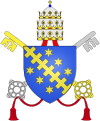


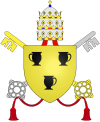




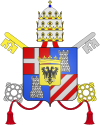






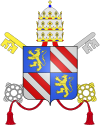
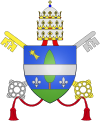


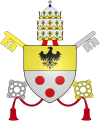









3 comments:
All the Popes were anti-Christ. They ALL serve Lucifer!
Yes anonymous - so true.
THOUSANDS of years of MANIPULATION, DO NOT BELIEVE A WORD out of the Vatican and/or out of the mouth of any priest or Jesuit either!
STOP GIVING MONEY TO THIS EVIL ENTITY that needs to be fully prosecuted beginning with assisting HITLER with all of his atrocities!
DO NOT ALLOW the resigned POPE to escape into never-never land!
DO NOT ALLOW the Vatican to ordain another EVIL POPE...STOP THE INSANITY.
ROMAN CATHOLICS, for the love of GOD (yes you read that correct) - STOP PARTICIPATING in their evil ways!
When EVERYONE STOPS attending their churches and stops sending them money and STOPS paying attention to their happy crap, they will fade away (hopefully all in jail)!
If you are a Catholic reading this, write to your Priest and tell that man to step down...otherwise, he will be held for prosecution of the lies that have been told to all of the people he has served mass to! THE CATHOLIC CHURCH IS GUILTY OF CRIMES AGAINST HUMANITY and the needs to be held accountable (fyi former R.C. so I am fully aware of the BS they spew out of their mouths every sunday, every holiday, every chance they can to try and brain-wash along with steal the money from the people).
YOU ARE A WORTHY ABUNDANT LOVED BEING...stop listening to these evil psycho-paths!
FYI THE BIBLE WAS RE-WRITTEN TO KEEP THE MASSES IN LINE AND TO STEAL THEIR MONEY. IT HAS ALSO BE ORCHESTRATED TO LOOK like "prophecy" since they CONTROL IT ALL.
PLEASE wake-up!
Amen and AMEN
Post a Comment